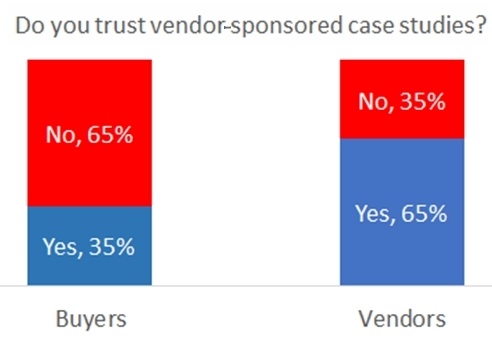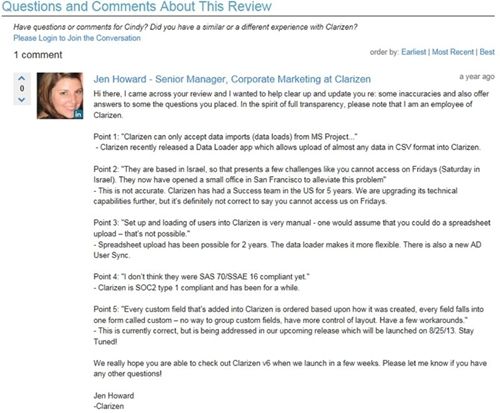Social media management software company Viralheat invited me to participate in a Twitter chat about best-practices in word-of-mouth marketing (WOM) in the form of online reviews. This article is a summation of that chat session.
1. Why Develop an Online Review Program
Do reviews help brands get more interest/business?
Absolutely. There's a large and established body of evidence in B2C (business-to-consumer) marketing that online reviews measurably increase conversion rates. Companies with positive reviews on TrustRadius (the company I founded and head as CEO) have reported generating new leads as well as success using their reviews to aid conversion.
(Buyers use it to build their short list or make a final selection. During the Twitter chat, Viralheat itself tweeted that it has garnered leads as a result of the reviews of its software.)
Online reviews appear in search results when people are evaluating your product or service, and professionals regularly frequent review sites when searching for solutions. Potential prospects discover your product as they evaluate competitors or research a category.
WOM marketing has been around for a long time. Why is it gaining higher traction these days?
Social media and search have accelerated WOM. For business software specifically, more than 80% of buyers begin their evaluations through search. In addition to visiting vendor websites, they're looking for independent insights, especially those from their peers.
Some 65% of business software buyers say they don't trust vendor-produced case studies, according to a a survey we conducted:

Moreover, younger generations who've grown up with sites such as Yelp and Amazon have less trust in brands and more trust in peers. Technologies such as Influitive for influencer marketing have also been catalysts for amplifying WOM.
Do you ever think there is an objective review, or is it always inherently biased?
Every review represents one person's or potentially one company's perspective. It's accurate from their vantage point; however, the limitation is that they may have a unique use case, an odd set-up, or limited experience in other tools for true comparison. Moreover, they may not represent a situation similar to yours as a buyer.
No review should be taken in isolation. What's important is the composite perspective from multiple reviews, combined with having sufficient insight on the reviewer's context, and the ability to filter reviews to find the most representative for your own scenario.
2. How to Get Reviews
Writing reviews can be time-consuming. How can you encourage users to write them?
You need to ask regularly. Just as with any form of marketing, it can require many touches. Think about asking for a review at key milestones in the customer lifecycle: post-sale, post-implementation, first ROI, first anniversary, renew... You could also ask post-resolution of customer support requests.
If someone has already written a review, ask that person to update or augment the existing review vs. writing a new one.
In terms of motivation, many people want to have their opinion heard, so asking earnestly for honest feedback works best. You can also emphasize that writing a thoughtful review can also be a way to embellish their professional profile. (Many TrustRadius members, for example, link to their reviews from their LinkedIn profiles.)
Reviews can be anonymous, however, possibly inviting more candid feedback, while also opening up the possibility of phony positive reviews.
Which department should be in charge of asking for and maintaining reviews?
Review programs commonly originate in Marketing, as that's where the primary benefit is derived. Ultimately, the customer success function should own an ongoing program, as it has the most touchpoints and the deepest relationship with customers. Keeping a program in Marketing keeps it episodic or campaign-oriented vs. truly programmatic.
Are there any specific characteristics of successful WOM campaigns?
Successful campaigns cast a wide net both in terms of customers and contacts at a customer targeted. Go beyond your primary business relationship point of contact to include all known users of your product. Expect a <5% response rate to any given campaign.
What do you look for in a good review?
Beyond validating authenticity, we look for balance and quality of insight. Specifically, whether the reviewer articulates the use case and provides specific insights that can help someone make an informed decision. We elicit the strongest possible reviews by asking a series of leading questions. In addition, we use gamification to encourage high-quality answers. Finally, we grade every review before publishing, and that, along with how the community reacts, will determine the sort of order in which reviews get displayed first on our site.
How do you deflect spam or loaded reviews?
Quality control should be a huge emphasis. You can require reviewers to authenticate themselves via LinkedIn, and you can check via human inspection to ensure that the person is a legitimate reviewer—and not, say, a competitor or an employee of the company being reviewed. You can also require that reviewers state whether they have actually used the product, for how long, and when they used it.
3. Responding to and Harnessing Reviews
How can reviews help other departments, such as Customer Success or Sales?
Reviews can be a valuable source of feedback for customer success. If support or account management is strong, that's invariably highlighted in a review. The same applies, though, if it's weak. Reviews can be an early warning signal—well before a renewal—of where intervention is required.
Reviews can also be a valuable asset for sales. Sales reps have used positive reviews to overcome obstacles in deal cycles by providing valuable social proof.
You can think of online reviews as the modern day alternative to a reference program. Reps can point prospective customers to reviews. Prospects can elect to connect with the reviewers for deeper conversations as required. The whole process becomes a lot less burdensome for all parties involved.
What KPIs should companies pay attention to in relation to reviews and WOM?
As you get a review program off the ground, focus on representation, because you don't want to be the only company in a category without reviews. Once you have a few reviews in place, it's important to ensure representativeness, both in number and customer mix if you serve multiple segments. Studies in the B2C space have shown that 20 reviews constitutes critical mass. In B2B, it's important to have a representative sample of customers so that people can filter to find at least one user like themselves.
Though it's easy to obsess about ratings, the content of what's said in reviews is ultimately more important. Ratings are an indicator of macro sentiment, but in of themselves they do not indicate that a product is a good match: The same study (of Amazon book reviews) found that star rating had much less influence than the content of review.
Ultimately the key metric to focus on is what percentage of prospective buyers read your reviews and, second, how influential the reviews are in their decision. There's increasing evidence that reviews are becoming a prevalent factor in decision-making.
Have you ever dealt with companies upset at their reviews?
Yes. A couple of times companies have escalated the situation when they had concerns with a review, questioning whether the reviewer was a real customer. In a couple of cases, we elected to remove those reviews, and in other cases we were able to affirm that the reviewer had indeed recently used the product, though perhaps not at their current employer. In those cases, we encourage the vendor to write a response. We've only had to take down three out of over 6,000 reviews we've published.
How can a brand or company combat bad reviews? Do you suggest replies?
Companies should absolutely respond. They should acknowledge mistakes, correct inaccuracies, and take the dialog offline for resolution. The tone should be constructive and non-defensive. Another strategy is to offset a negative review with additional reviews to provide a more balanced perspective.
Here's an example of a company writing a thorough response:
How can companies leverage good reviews as assets?
Companies can quote from good reviews in their collateral, including their websites. For example, in our case, some use our review widget to syndicate reviews onto their websites as social proof.
When we have written industry reports based on review data and assigned badges based on raking, many have chosen to display those rankings, as further social proof.
Sales reps regularly point prospects to specific reviews to help convince them and remove obstacles. Some companies use as demand generation assets the research that we've written based on reviews of their product or category.





